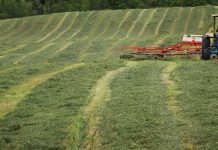Although it seemed that we went directly from winter to summer this year, the intensity of the summer heat and humidity just kicked into gear. And, the toll on the cows is certainly being noticed.
Feed intake at calving is typically rather low and cows calving in the summer experience lower feed intake after parturition, which increases their risk for metabolic diseases.
It is well recognized that the majority of metabolic diseases occur within the first 30 days in milk and involuntary culling of cows during the first 30 to 60 days in milk is very costly to the dairy enterprise. Thus, feeding management during the dry period and with fresh cows is fundamental in reducing the risk of metabolic diseases after calving.
The science
The two primary metabolic diseases, either directly or indirectly, for fresh cows are ketosis and subclinical hypocalcemia (SCHC). The risks for these diseases increases with low dry matter intake after calving.
In 2017, Spanish researchers published the results of a study on SCHC in dairy cows in the Journal of Dairy Science. They defined hypocalcemia in its clinical form as total serum Ca concentration <1.50 mM and the subclinical form as total serum Ca concentration ≤ 2.14 mM.
The objective of the study was to assess potential associations between SCHC and displaced abomasum, intramammary infections, metritis, retained placenta, and ketosis. Also, the associations between SCHC and milk yield and reproductive function were evaluated.
After discarding 32 cows with clinical hypocalcemia, a total of 764 cows from six commercial farms were enrolled in this study.
Blood samples were collected at 24 to 48 hours post-calving for analysis of total Ca concentration. Of the cows analyzed, 78 percent incurred SCHC. The occurrence of displaced abomasum (3.7x), ketosis (5.5x), retained placenta (3.4x), and metritis (4.3x) was more likely in cows that had SCHC than in healthy cows. The risk of incurring retained placenta or metritis increased in multiparous versus first-lactation cows as serum Ca concentrations decreased.
Healthy cows, independent of parity, were more likely to show their first estrus sooner after calving than SCHC cows.
In this study, there was no difference in milk yield during the first 60 days in milk between SCHC and healthy cows. It has been reported in some other work that cows with SCHC have higher milk yield, which is likely because higher-producing cows are at higher risk for SCHC.
It is well established that cows with clinical hypocalcemia have reduced milk yield; however, SCHC is a frequent disorder on dairy farms that affects cow performance, increases the risk for other diseases, and thus reduces profitability.
Lower pregnancy rates typically occur during the summer, which may be caused by several factors, but SCHC may be a contributing factor as it relates to health of the reproductive tract.
Talk to nutritionist
It would be a good time with the onset of the high temperature and humidity and recent new harvests of grass and legume forages to work with your nutritionist to get forage tests conducted, review the mineral and vitamin concentrations in rations for dry and fresh cows, and evaluate the feeding management of these cows.













